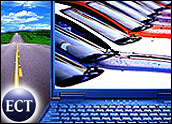
Some types of commerce are just not a match for the Internet. However, others — including researching a new car — caught on with online shoppers. The amount and types of information that can be conveyed online has brought car-buying to a whole new level — yet few auto marketers are optimizing their use of the medium.
New-car shoppers prefer visual material such as photos and video over textual material by a margin of two to one, according to a new survey by CarGurus. During the six months from March to August 2007, CarGurus tracked visitors researching new cars on its site.
Page views for different types of research were summarized and allocated into two types of activities: visual (photos and videos) and textual (user reviews, articles, specifications, pricing, etc.). Higher page views generally indicate a more engaged viewer spending more time at a site. During this time frame, CarGurus received over 1.1 million unique visitors.
The study found that new-car shoppers spend the majority of their time (62 percent, or nearly two-thirds of pages viewed) looking at photos and videos versus more traditional forms of online auto research such as specifications, reviews and pricing.
This demonstrates that — in an industry that typically highlights textual information — online auto marketers should take note of the growing demand for visuals.
Buyers Looking Beyond the Sunday Paper
Ten years ago, before auto manufacturer Web sites were common, consumers basically had two options for research: visit the dealer or pore through the pages of newspapers. Now, consumers have a plethora of new resources, including auto manufacturer sites, industry expert sites such as Consumer Reports, and third-party sites with user-generated content such as CarGurus, Yahoo Autos and Edmunds.
Consumption of user-generated content is growing at a particularly rapid rate, according to Forrester Research, which cited in a report that 29 percent of new-car shoppers view automotive user-generated content. That’s nearly the same number that reported gathering information from magazines, newspapers and TV combined the last time they bought a car.
Given these new resources and the explosive growth of online photo and video sites like Flickr and YouTube, it is not surprising to see that new-car shoppers prefer to research cars online with visual mediums. However, what is surprising is to see how many online auto marketers neglect to spotlight the visual aspects of a new car and instead choose to highlight textual lists of features and specifications, with the occasional promotion (special headlamps, DVD systems or extended warranties, for instance) thrown in for good measure.
A quick tour of major auto manufacturers’ Web sites shows that very few have video, and though photo galleries are more common, they are generally limited to fewer than a dozen photos.
Helping Consumers Fall in Love With a Car
With the proliferation of broadband connections, online video and robust picture galleries provide an opportunity for online auto marketers to create more visual campaigns. Cars are an emotional purchase. Providing visual research tools allows consumers to connect with a car emotionally — to fall in love with it instead of just being introduced.
In spite of this opportunity, most online automotive marketing campaigns in the form of banner advertisements take consumers to landing pages packed with verbiage, rather than providing material with visual impact to further draw consumers into the brand.
One example of an auto manufacturer that is addressing the consumer’s stated desire for pictures and video is Toyota’s current Tundra campaign. Banner ads for the Toyota Tundra take would-be buyers to a landing page where the consumer is immediately immersed in a video about the truck.
After the video ends, Toyota presents a marketing message differentiating the Tundra based on its braking power. Typical landing pages for other automotive banner advertisements recite statistics or grids of features. Toyota, however, has done a magnificent job of engaging the consumer with this campaign.
Encouraging Brand Affinity
Another great example is Porsche USA, which provides not only video footage of each vehicle on its Web site but also offers screensavers and wallpaper that help encourage strong brand affinity and an emotional connection between the consumer and the car.
The CEO of Kia reported at Forrester’s 2007 Marketing Forum that consumers who visited Kia.com were 60 percent more likely to buy a Kia. That’s a stunning figure. Imagine how much more loyalty auto manufacturers could inspire if they were to truly leverage the interactivity and visual nature of the Web medium, rather than treating it as an online brochure.
The people have spoken, and they want visuals. Auto marketers: Will you deliver?
Langley Steinert is founder and CEO of the online automotive community CarGurus. He is a former chairman of the online travel information site TripAdvisor, which he cofounded.



































Driving a vehicle with manual transmission, also known as a stick shift, can be for many drivers young and old. Many motorists go through life without owning or ever even driving a stick shift, but it is a good skill to have as these types of vehicles are popular.
———————————
pandreson